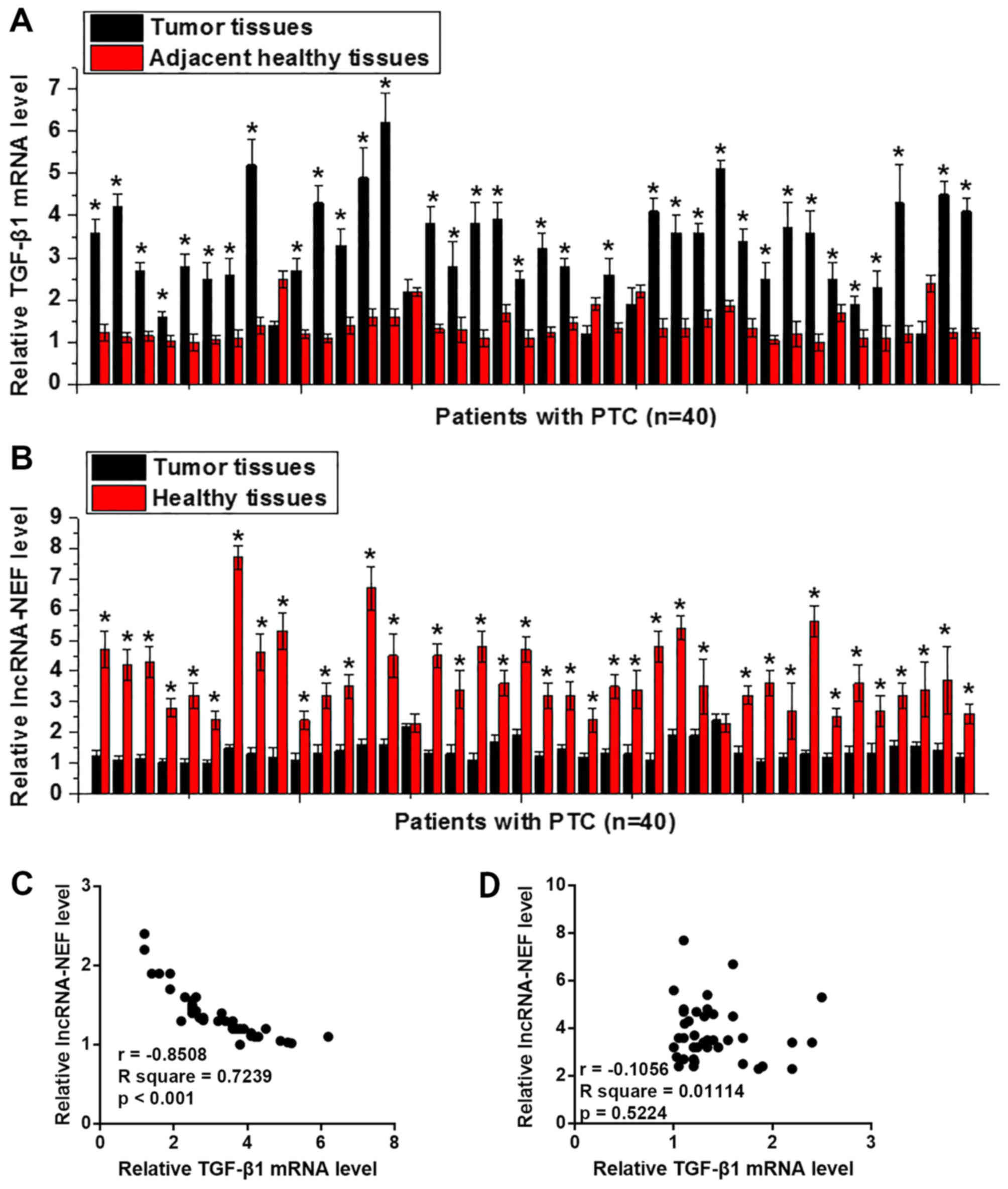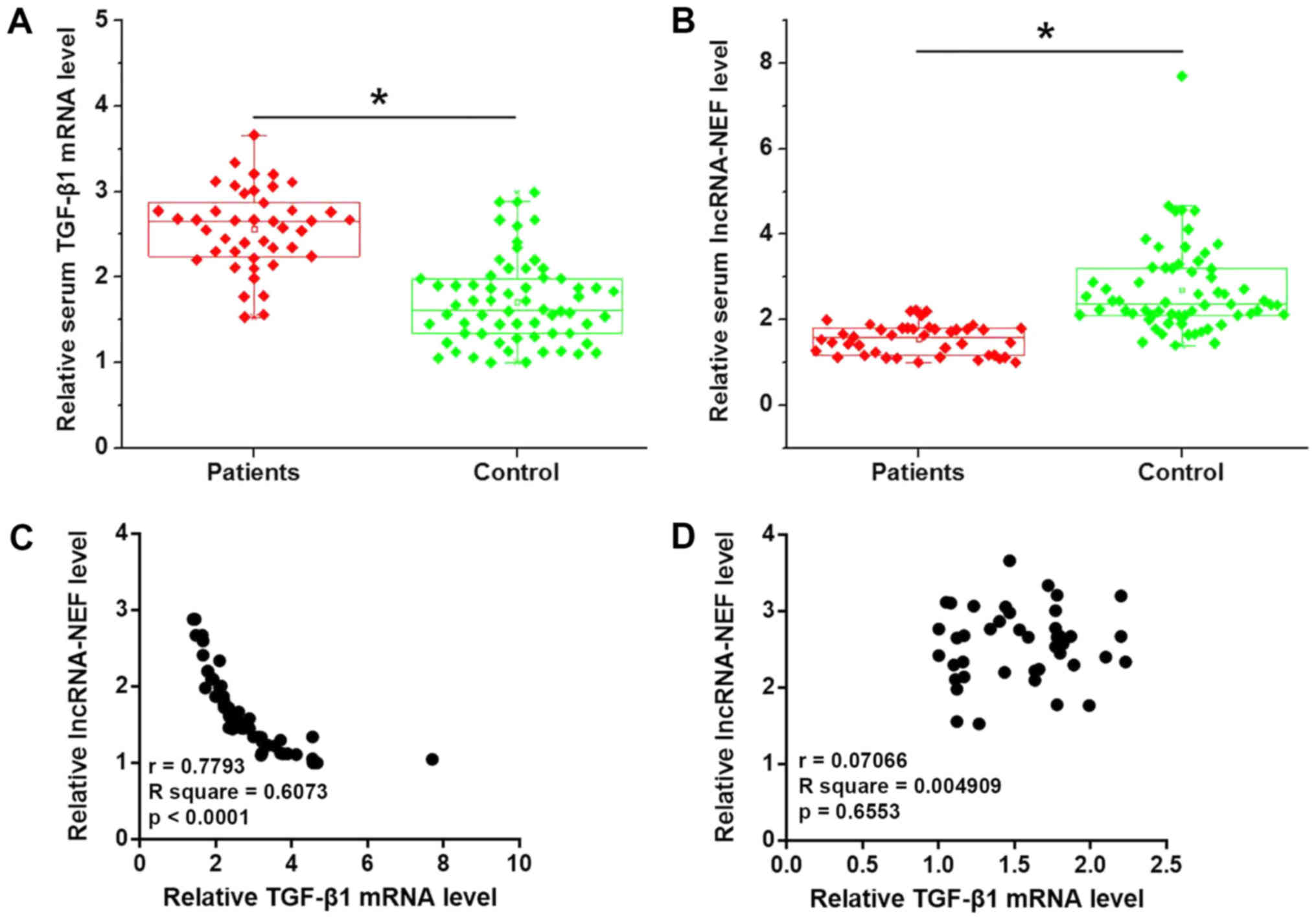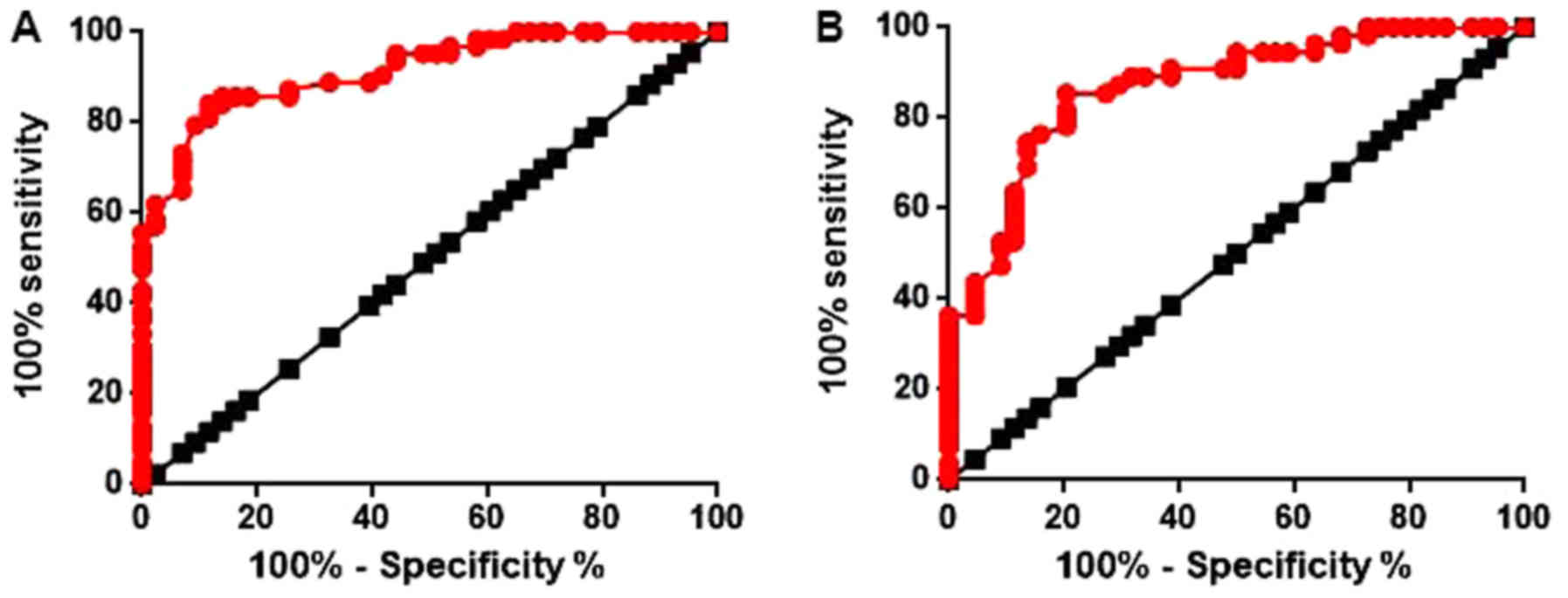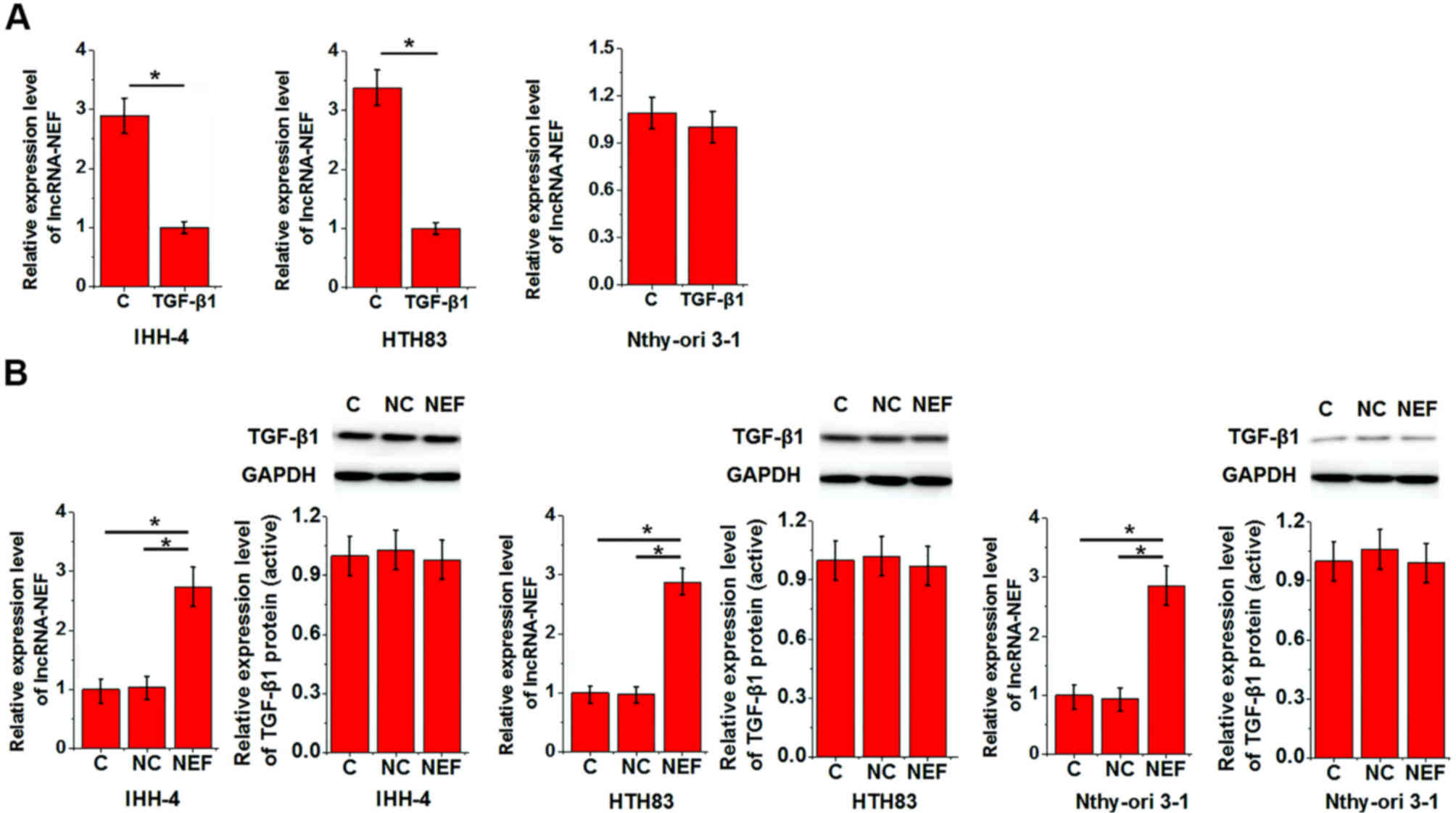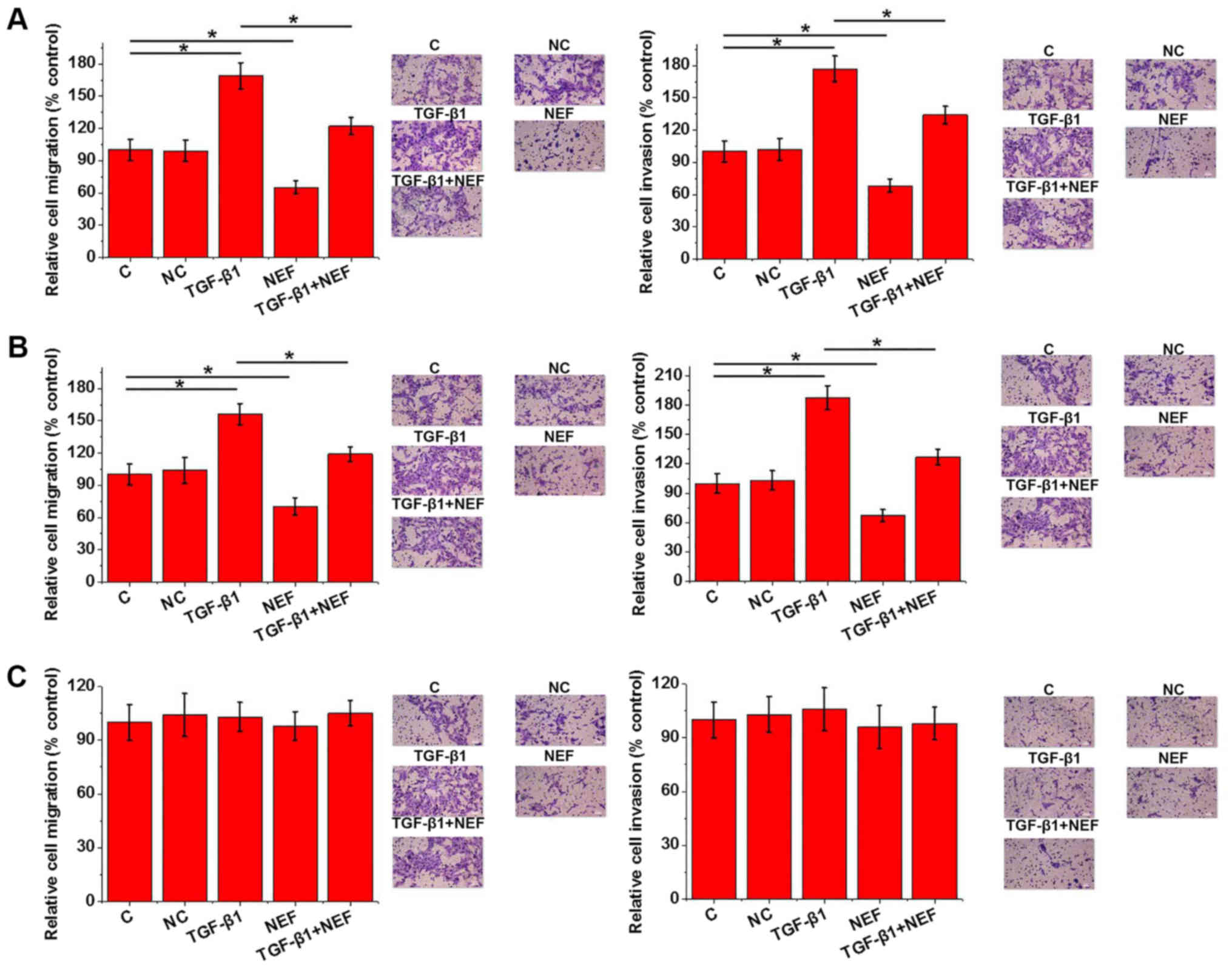TGF‑β1 promotes the invasion and migration of papillary thyroid carcinoma cells by inhibiting the expression of lncRNA‑NEF
- Authors:
- Published online on: January 18, 2019 https://doi.org/10.3892/ol.2019.9947
- Pages: 3125-3132
-
Copyright: © Xie et al. This is an open access article distributed under the terms of Creative Commons Attribution License.
Abstract
Introduction
Papillary thyroid carcinoma (PTC) is the most common type of thyroid cancer. It originates from follicular cells in the simple unicellular epithelium of the thyroid (1). Incidence of this disease has tripled in recent decades, mostly due to alterations in lifestyle and air pollution. In addition, the age of onset of this disease has reduced (2). Treatment outcomes of PTC are satisfactory and, with appropriate treatment, >95% of patients with PTC survive >5 years after diagnosis (3,4). However, recurrence is very common once tumor metastasis has developed, which markedly impacts the survival of these patients (5). Additional lethal thyroid cancers may occasionally develop from PTC (1). Therefore, the treatment and prevention of PTC must be improved.
The expression levels of transforming growth factor-β1 (TGF-β1) are altered in patients with PTC and lymph node metastasis (5), thus suggesting that TGF-β1 may be associated with metastasis. However, the mechanisms of action of TGF-β1 and its functions in PTC remain unclear (6). The long non-coding RNA (lncRNA)-neighboring enhancer of forkhead box A2 (NEF) is a newly discovered lncRNA that inhibits epithelial to mesenchymal transition in hepatocellular carcinoma (7). However, its involvement in other types of malignancy is unknown. Preliminary microarray data revealed reverse expression patterns of lncRNA-NEF and TGF-β1 in PTC tissues (data not shown). Therefore, in the present study, the involvement of TGF-β1 and lncRNA-NEF in PTC was further investigated. The results demonstrated that TGF-β1 may promote invasion and migration of PTC cells by inhibiting lncRNA-NEF expression.
Materials and methods
Patients
A total of 62 patients with PTC who were initially diagnosed and treated at the Affiliated Xinhua Hospital of Dalian University (Dalian, China) between January 2015 and January 2018 were included in this study. Patients with other types of malignancies, severe diseases and thyroid diseases, and patients who had received treatment prior to admission were excluded. The patients comprised 35 men and 27 women, aged between 22 and 72 years old, with a mean age of 45±9.8 years. Lymph node metastasis was found in 27 patients. In addition, 42 healthy volunteers were enrolled in this study, which represented the control group. The control group comprised 20 men and 22 women, aged between 24 and 69 years old, with a mean age of 44±10.2 years. No differences in age and sex were detected between the two groups. The study was approved by the Ethics Committee of the Affiliated Xinhua Hospital of Dalian University, and all patients provided written informed consent.
Specimen collection
The present study included 62 patients with PTC, of which 40 received surgical tumor resection. During tumor resection, tumor tissues and adjacent healthy tissues were collected. All patients exhibited normal thyroid function prior to surgery, and none of them received radiotherapy or chemotherapy prior to admission to hospital. Blood (15 ml) was extracted from the elbow vein of all 62 patients with PTC and 42 healthy controls. Blood was maintained at room temperature for 2 h, followed by centrifugation at 1,087 × g for 20 min to collect serum. All tissues and serum were stored in liquid nitrogen for long-term use.
Cell lines and cell culture
The present study used two human PTC cell lines, IHH-4 and HTH83, and the normal thyroid follicular epithelial cell line Nthy-ori 3-1 (all from American Type Culture Collection, Manassas, VA, USA). All cells were cultured in Dulbecco's modified Eagle's medium (Gibco; Thermo Fisher Scientific, Inc., Waltham, MA, USA) supplemented with 10% fetal bovine serum (Gibco; Thermo Fisher Scientific, Inc.), 100 U/ml streptomycin and 100 mg/ml penicillin G (Gibco; Thermo Fisher Scientific, Inc., Waltham, MA, USA) at 37°C in a humidified incubator containing 5% CO2. Cells treated with TGF-β1 (cat. no. T7039-2UG; Sigma-Aldrich; Merck KGaA, Darmstadt, Germany) were cultured in serum-free medium for 12 h. Cell treatment with TGF-β1 was performed at 10 ng/ml, for 24 h at 37°C as recommended by the supplier.
Reverse transcription-quantitative polymerase chain reaction (RT-qPCR)
TRIzol® reagent (Invitrogen; Thermo Fisher Scientific, Inc.) was used to extract RNA from tissues and cells. Tumor tissues and adjacent healthy tissues were ground in liquid nitrogen prior to the addition of TRIzol® reagent. RNA samples were tested by NanoDrop™ 2000 Spectrophotometer (NanoDrop; Thermo Fisher Scientific, Inc., Wilmington, DE, USA), and RNA samples with an A260/A280 ratio between 1.8 and 2.0 underwent RT to synthesize cDNA using AMV reverse transcriptase (Gibco; Thermo Fisher Scientific, Inc.) according to the manufacturer's protocol. TaqMan PCR kit (Thermo Fisher Scientific, Inc.) was used to prepare PCR, and PCR reactions were carried out on a Bio-Rad iCycler (Bio-Rad Laboratories, Inc., Hercules, CA, USA). The primer sequences used for RT-qPCR were as follow: TGF-β1, forward 5′-GGCCTTTCCTGCTTCTCATGG-3′, reverse 5′-CCTTGCTGTACTGCGTGTCC-3′; lncRNA-NEF, forward 5′-CTGCCGTCTTAAACCAACCC-3′, reverse 5′-GCCCAAACAGCTCCTCAATT-3′; and GAPDH, forward 5′-CAGGAGGCATTGCTGATGAT-3′, reverse 5′-GAAGGCTGGGGCTCATTT-3′. PCR reaction conditions were as follow: 95°C for 50 sec, followed by 40 cycles at 95°C for 12 sec and 56°C for 35 sec. Relative expression levels of TGF-β1 and lncRNA-NEF were normalized to the endogenous control GAPDH using the 2−ΔΔCq method (8).
Construction of lncRNA-NEF expression vector and transfection
Full-length lncRNA-NEF cDNA (Sangon Biotech, Co., Ltd., Shanghai, China) with U6 promoter was inserted into a pcDNA3.1 vector (Sangon Biotech, Co., Ltd.) to establish a lncRNA-NEF expression vector. Lipofectamine® 2000 transfection reagent (cat no. 11668-019, Invitrogen; Thermo Fisher Scientific, Inc.) was used to transfect 5×105 cells with 10 nM vector. Transfection with an empty vector was used as a negative control. After 48 h, cells were collected for subsequent experiments. In cases of TGF-β1 treatment, TGF-β1 (10 ng/ml) was added at 24 h following transfection.
Transwell migration and invasion assays
Cells collected during the logarithmic growth phase were used to prepare single cell suspensions at a final density of 5×104 cells/ml. In cases of TGF-β1 treatment, TGF-β1 (10 ng/ml) was added at 24 h after transfection, followed by migration and invasion assay. For the Transwell migration assay, 0.1 ml volume of the 5×104 cells/ml suspension was transferred to the upper chamber, and RPMI-1640 medium (Gibco; Thermo Fisher Scientific, Inc.) supplemented with 20% fetal calf serum (Sigma-Aldrich; Merck KGaA) was used to fill the lower chamber. After 24 h, membranes were collected and stained with 0.5% crystal violet (Sigma-Aldrich; Merck KGaA) at room temperature for 20 min. Prior to the invasion assay, the upper chamber was pre-coated with Matrigel (cat no. 356234; EMD Millipore, Billerica, MA, USA); all other steps were the same as for the migration assay. Cells were observed and counted under Olympus BH2 microscope (Tokyo, Japan).
Western blotting
Cell lysis buffer (cat no. P0013K; Beyotime Institute of Biotechnology, Haimen, China) was used to extract total protein from cells, and protein concentration was determined using the bicinchoninic acid assay. Proteins were separated by 10% SDS-PAGE with 30 µg per well and were transferred onto polyvinylidene difluoride membranes. Membranes were then blocked with 5% skimmed milk at room temperature for 1 h, prior to incubation with the following primary antibodies: Rabbit anti-TGF-β1 (1:2,000, cat no. ab9758; Abcam, Cambridge, UK) and rabbit anti-GAPDH (1:2,000, cat no. ab37168; Abcam) overnight at 4°C. After washing with Tris-buffered saline-0.3% Tween (TBST), membranes were incubated with anti-rabbit immunoglobulin G-horseradish peroxidase secondary antibody (1:1,000, cat no. MBS435036; MyBioSource, Inc., San Diego, CA, USA) at room temperature for 2 h. After washing with TBST, bands were detected using enhanced chemiluminescence substrate (Sigma-Aldrich; Merck KGaA). Relative expression levels of TGF-β1 were normalized to the endogenous control GAPDH using ImageJ V1.6 (National Institutes of Health, Bethesda, MD, USA).
Statistical analysis
Statistical analyses were performed using SPSS 19.0 (IBM Corp., Armonk, NY, USA). Experiments were performed in triplicate manner and data are presented as the means ± standard deviation. Comparisons between two groups were performed by un-paired t test, and comparisons among multiple groups were performed by one-way analysis of variance followed by Tukey's post-hoc test. Comparisons between tumor and adjacent healthy tissues were performed by a paired t-test. Pearson correlation coefficient analysis was performed to analyze the correlation between TGF-β1 mRNA and lncRNA-NEF expression. Associations of serum levels of TGF-β1 mRNA and lncRNA-NEF with clinicopathological data of patients were analyzed by χ2 test. Receiver operating characteristic (ROC) curve analysis was performed to evaluate the diagnostic values of serum TGF-β1 mRNA and lncRNA-NEF for patients with PTC and healthy controls. P<0.05 was considered to indicate a statistically significant difference.
Results
Expression of TGF-β1 mRNA and lncRNA-NEF in PTC tissues and adjacent healthy tissues from patients with PTC
The expression levels of TGF-β1 and lncRNA-NEF were detected in the tumor tissues and adjacent healthy tissues of 40 patients with PTC using RT-qPCR. As shown in Fig. 1A, the expression levels of TGF-β1 were significantly upregulated in tumor tissues compared with in adjacent healthy tissues in 35 out of 40 patients (P<0.05). Conversely, lncRNA-NEF expression was significantly downregulated in tumor tissues compared with in adjacent healthy tissues in 38 out of 40 patients (P<0.05; Fig. 1B). In addition, the expression levels of TGF-β1 mRNA and lncRNA-NEF were negatively correlated in tumor tissues (Fig. 1C), but not in adjacent healthy tissues (Fig. 1D). These data suggested that upregulation of TGF-β1 and downregulation of lncRNA-NEF may be involved in the pathogenesis of PTC.
Expression of TGF-β1 mRNA and lncRNA-NEF in the serum samples of healthy subjects and patients with PTC
As shown in Fig. 2A, serum levels of TGF-β1 were significantly higher in patients with PTC than in healthy subjects (P<0.05). Conversely, serum levels of lncRNA-NEF were significantly lower in patients with PTC than in healthy subjects (P<0.05; Fig. 2B). In addition, serum TGF-β1 mRNA and lncRNA-NEF were negatively correlated in patients with PTC (Fig. 2C), but not in healthy subjects (Fig. 2D).
Diagnostic values of serum TGF-β1 mRNA and lncRNA-NEF for PTC
ROC curve analysis was performed to evaluate the diagnostic values of serum TGF-β1 mRNA and lncRNA-NEF for PTC. The area under the curve (AUC) of serum TGF-β1 in the diagnosis of PTC was 0.9153 with a 95% confidence interval (CI) of 0.8644–0.9661 (P<0.0001; Fig. 3A). The AUC of serum lncRNA-NEF in the diagnosis of PTC was 0.8686 with a 95% CI of 0.7984–0.9388 (P<0.0001; Fig. 3B). These data suggested that serum TGF-β1 mRNA and lncRNA-NEF may serve as potential biomarkers for the diagnosis of PTC.
Associations of serum levels of TGF-β1 mRNA and lncRNA-NEF with clinicopathological data of patients
According to the median serum levels of TGF-β1 mRNA and lncRNA-NEF, patients were divided into the high-expression and low-expression groups (n=31). The associations of serum levels of TGF-β1 mRNA and lncRNA-NEF with clinicopathological data of patients with PTC was analyzed by χ2 test. As shown in Tables I and II, serum levels of TGF-β1 mRNA and lncRNA-NEF were not significantly associated with sex, age, smoking and drinking habits, and tumor size. However, serum levels of TGF-β1 mRNA and lncRNA-NEF were significantly associated with lymph node metastasis.
Interactions between TGF-β1 and lncRNA-NEF
In the present study, lncRNA-NEF overexpression reduced the enhancing effects of TGF-β1 on cell migration and invasion. To further investigate the interactions between TGF-β1 and lncRNA-NEF, IHH-4, HTH83 and Nthy-ori 3-1 cells were treated with TGF-β1 (10 ng/ml) and underwent lncRNA-NEF expression vector transfection. The expression levels of TGF-β1 (25 kD active homodimer) and lncRNA-NEF were then detected. As shown in Fig. 4A, TGF-β1 treatment significantly downregulated the expression levels of lncRNA-NEF in IHH-4 and HTH83 cell lines, but not in the Nthy-ori 3-1 cell line, whereas lncRNA-NEF overexpression exhibited no significant effects on TGF-β1 expression in all three cell lines (Fig. 4B).
Effects of TGF-β1 treatment and lncRNA-NEF overexpression on cell migration and invasion
As determined in the present study, TGF-β1 and lncRNA-NEF were associated with tumor metastasis. In the present study, two human PTC cell lines, IHH-4 and HTH83, and the Nthy-ori 3-1 normal thyroid follicular epithelial cell line, were treated with TGF-β1 (10 ng/ml) and underwent lncRNA-NEF expression vector transfection. Cell migration and invasion were then detected by Transwell migration and invasion assays. As presented in Fig. 5, TGF-β1 promoted cell migration and invasion of IHH-4 (Fig. 5A) and HTH83 (Fig. 5B) cell lines; however, lncRNA-NEF overexpression inhibited these phenomena. In addition, lncRNA-NEF overexpression reduced the enhancing effects of TGF-β1 on cell migration and invasion (Fig. 5A and B). However, TGF-β1 treatment and lncRNA-NEF overexpression exhibited no significant effects on cell migration and invasion of the normal thyroid follicular epithelial cell line (Fig. 5C).
Discussion
Since its pathogenesis is unclear, PTC is associated with a high rate of recurrence following treatment; therefore, research regarding the molecular pathogenesis and mechanisms underlying PTC is important (9). The development of PTC is a complex process involving numerous internal and external factors. It has been reported that male sex and elevated age are two important risk factors for PTC (10). In addition, various signaling pathways, including the WNT-β-catenin signaling pathway (11), hypoxia inducible factor-1α pathway (12) and thyroid-stimulating hormone receptor signaling pathway (13), are involved in the pathogenesis of PTC. TGF-β signaling serves important roles in tumor suppression and cancer progression (14). It has been reported that expression of TGF-β1 is significantly upregulated in patients with PTC compared with in healthy subjects (5). In the present study, the expression levels of TGF-β1 were significantly upregulated in tumor tissues compared with in healthy tissues in 35 out of 40 patients with PTC, thus confirming the overexpression of TGF-β1 in PTC. LncRNA-NEF is a newly identified lncRNA that functions as a tumor suppressor gene in hepatocellular carcinoma (7). However, its involvement in other malignancies remains unknown. In the present study, the expression of lncRNA-NEF was significantly downregulated in tumor tissues compared with in healthy tissues in 38 out of 40 patients with PTC. Taken together, these data suggested that upregulation of TGF-β1 and downregulation of lncRNA-NEF may be involved in the pathogenesis of PTC.
Blood markers have been widely used in the early diagnosis of cancer (15,16). In the present study, TGF-β1 mRNA and lncRNA-NEF serum levels were able to distinguish between patients with PTC and healthy controls, suggesting that they may serve as potential diagnostic markers for PTC. However, it has been reported that gene expression is affected by aging (17), smoking (18) and drinking (19) habits. In the present study, serum levels of TGF-β1 mRNA and lncRNA-NEF exhibited no significant association with age, sex or drinking and smoking habits. These results suggested that serum TGF-β1 mRNA and lncRNA-NEF may be reliable diagnostic markers for PTC.
The present study also revealed that the serum levels of TGF-β1 mRNA and lncRNA-NEF were closely associated with lymph node metastasis, but not tumor size, indicating their involvement in tumor metastasis. Transwell assays demonstrated that TGF-β1 promoted cell migration and invasion of IHH-4 and HTH83 cell lines, but not the Nthy-ori 3-1 cell line, whereas lncRNA-NEF overexpression had the opposite effects. These results suggested that TGF-β1 and lncRNA-NEF may be potential targets for the treatment of PTC. It is well known that the TGF-β pathway interacts with lncRNAs to achieve its biological functions (20,21). In this study, lncRNA-NEF overexpression reduced the enhancing effects of TGF-β1 on cell migration and invasion. In addition, TGF-β1 treatment significantly downregulated the expression levels of lncRNA-NEF in IHH-4 and HTH83 cell lines, but not in the Nthy-ori 3-1 cell line. Conversely, lncRNA-NEF overexpression exerted no significant effects on TGF-β1 expression in all three cell lines. These data suggested that TGF-β1 may be an upstream inhibitor of lncRNA-NEF in PTC; however, the mechanisms underlying the regulatory effects of TGF-β1 on lncRNA-NEF are still unknown. TGF-β1 is unlikely to be a direct target of lncRNA-NEF due to its lack of a direct targeting site. It is possible that some pathological factors may mediate the interactions between lncRNA-NEF and TGF-β1. Our future studies aim to identify these mediators.
In conclusion, in this study, TGF-β1 was upregulated, whereas lncRNA-NEF was downregulated in PTC. In addition, it was suggested that TGF-β1 and lncRNA-NEF may be considered potential reliable diagnostic markers for PTC. Furthermore, TGF-β1 promoted and lncRNA-NEF overexpression inhibited cell migration and invasion of PTC cell lines, but not the normal cell line. TGF-β1 also inhibited the expression levels of lncRNA-NEF in PTC cell lines but not in the normal cell line; however, lncRNA-NEF overexpression had no effect on TGF-β1 expression. These results suggested that TGF-β1 may promote the invasion and migration of PTC cells by inhibiting the expression of lncRNA-NEF.
Acknowledgements
Not applicable.
Funding
No funding was received.
Availability of data and materials
The datasets used and/or analyzed during the present study are available from the corresponding author on reasonable request.
Authors' contributions
YW designed the experiments. JX performed all experiments. YL and XD analyzed data. And YW wrote the manuscript. All authors read and approved the final manuscript.
Ethics approval and consent to participate
The study was approved by the Ethics Committee of the Affiliated Xinhua Hospital of Dalian University, and all patients provided written informed consent.
Patient consent for publication
Patient signed informed consent for publication.
Competing interests
The authors declare that they have no competing interests.
References
|
Cancer Genome Atlas Research Network: Integrated genomic characterization of papillary thyroid carcinoma. Cell. 159:676–690. 2014. View Article : Google Scholar : PubMed/NCBI | |
|
Londero SC, Krogdahl A, Bastholt L, Overgaard J, Trolle W, Pedersen HB, Bentzen J, Schytte S, Christiansen P and Godballe C; Danish Thyroid Cancer Group, : Papillary thyroid microcarcinoma in Denmark 1996–2008: A national study of epidemiology and clinical significance. Thyroid. 23:1159–1164. 2013. View Article : Google Scholar : PubMed/NCBI | |
|
Olaleye O, Ekrikpo U, Moorthy R, Lyne O, Wiseberg J, Black M and Mitchell D: Increasing incidence of differentiated thyroid cancer in South East England: 1987–2006. Eur Arch Otorhinolaryngol. 268:899–906. 2011. View Article : Google Scholar : PubMed/NCBI | |
|
Hay ID, Thompson GB, Grant CS, Bergstralh EJ, Dvorak CE, Gorman CA, Maurer MS, McIver B, Mullan BP, Oberg AL, et al: Papillary thyroid carcinoma managed at the Mayo Clinic during six decades (1940–1999): Temporal trends in initial therapy and long-term outcome in 2444 consecutively treated patients. World J Surg. 26:879–885. 2002. View Article : Google Scholar : PubMed/NCBI | |
|
Ito Y, Miyauchi A, Kudo T, Kihara M, Fukushima M and Miya A: The effectiveness of prophylactic modified neck dissection for reducing the development of lymph node recurrence of papillary thyroid carcinoma. World J Surg. 41:2283–2289. 2017. View Article : Google Scholar : PubMed/NCBI | |
|
Wang N, Jiang R, Yang JY, Tang C, Yang L, Xu M, Jiang QF and Liu ZM: Expression of TGF-β1, SNAI1 and MMP-9 is associated with lymph node metastasis in papillary thyroid carcinoma. J Mol Histol. 45:391–399. 2014. View Article : Google Scholar : PubMed/NCBI | |
|
Liang WC, Ren JL, Wong CW, Chan SO, Waye MM, Fu WM and Zhang JF: LncRNA-NEF antagonized epithelial to mesenchymal transition and cancer metastasis via cis-regulating FOXA2 and inactivating Wnt/β-catenin signaling. Oncogene. 37:1445–1456. 2018. View Article : Google Scholar : PubMed/NCBI | |
|
Livak KJ and Schmittgen TD: Analysis of relative gene expression data using real-time quantitative PCR and the 2(-Delta Delta C(T)) method. Methods. 25:402–408. 2001. View Article : Google Scholar : PubMed/NCBI | |
|
Xing M: Molecular pathogenesis and mechanisms of thyroid cancer. Nat Rev Cancer. 13:184–199. 2013. View Article : Google Scholar : PubMed/NCBI | |
|
Shaha AR, Shah JP and Loree TR: Risk group stratification and prognostic factors in papillary carcinoma of thyroid. Ann Surg Oncol. 3:534–538. 1996. View Article : Google Scholar : PubMed/NCBI | |
|
Clevers H and Nusse R: Wnt/β-catenin signaling and disease. Cell. 149:1192–1205. 2012. View Article : Google Scholar : PubMed/NCBI | |
|
Zerilli M, Zito G, Martorana A, Pitrone M, Cabibi D, Cappello F, Giordano C and Rodolico V: BRAF(V600E) mutation influences hypoxia-inducible factor-1alpha expression levels in papillary thyroid cancer. Modern Pathol. 23:1052–1060. 2010. View Article : Google Scholar | |
|
Boelaert K, Horacek J, Holder RL, Watkinson JC, Sheppard MC and Franklyn JA: Serum thyrotropin concentration as a novel predictor of malignancy in thyroid nodules investigated by fine-needle aspiration. J Clin Endocrinol Metabol. 91:4295–4301. 2006. View Article : Google Scholar | |
|
Derynck R, Akhurst RJ and Balmain A: TGF-Beta signaling in tumor suppression and cancer pr. Nat Gene. 29:117–129. 2001. View Article : Google Scholar | |
|
Mitchell PS, Parkin RK, Kroh EM, Fritz BR, Wyman SK, Pogosova-Agadjanyan EL, Peterson A, Noteboom J, O'Briant KC, Allen A, et al: Circulating microRNAs as stable blood-based markers for cancer detection. Proc Natl Acad Sci USA. 105:10513–10518. 2008. View Article : Google Scholar : PubMed/NCBI | |
|
Hundt S, Haug U and Brenner H: Blood markers for early detection of colorectal cancer: A systematic review. Cancer Epidemiol Biomarkers Prev. 16:1935–1953. 2007. View Article : Google Scholar : PubMed/NCBI | |
|
Lee CK, Klopp RG, Weindruch R and Prolla TA: Gene expression profile of aging and its retardation by caloric restriction. Science. 285:1390–1393. 1999. View Article : Google Scholar : PubMed/NCBI | |
|
Zhou W, Liu G, Park S, Wang Z, Wain JC, Lynch TJ, Su L and Christiani DC: Gene-smoking interaction associations for the ERCC1 polymorphisms in the risk of lung cancer. Cancer Epidemiol Biomarkers Prev. 14:491–496. 2005. View Article : Google Scholar : PubMed/NCBI | |
|
Corella D: Gene-alcohol interactions in the metabolic syndrome. Nutr Metab Cardiovasc Dis. 17:140–147. 2007. View Article : Google Scholar : PubMed/NCBI | |
|
Huang Y, Zheng Y, Jia L and Li W: Long Noncoding RNA H19 promotes osteoblast differentiation via TGF-β1/Smad3/HDAC signaling pathway by deriving miR-675. Stem Cells. 33:3481–3492. 2015. View Article : Google Scholar : PubMed/NCBI | |
|
Yuan JH, Yang F, Wang F, Ma JZ, Guo YJ, Tao QF, Liu F, Pan W, Wang TT, Zhou CC, et al: A long noncoding RNA activated by TGF-β promotes the invasion-metastasis cascade in hepatocellular carcinoma. Cancer Cell. 25:666–681. 2014. View Article : Google Scholar : PubMed/NCBI |



